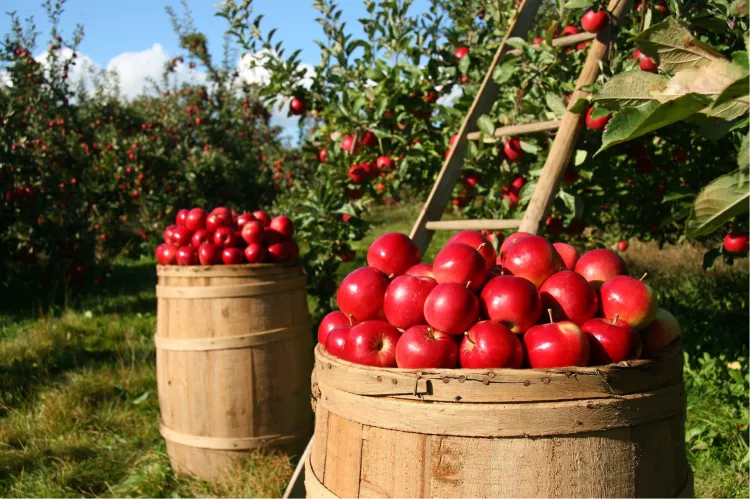
Weather patterns have been changing dramatically as the planet heats up. We’re all experiencing the effects of these changes, from severe flooding to poor air quality due to increased wildfires. While these kinds of changes affect the safety and daily lives of people all over the world, they also have a major impact on food production.
Agriculture has always been driven by the weather. The temperature, rainfall, wind, and other weather patterns have a huge impact on the success or failure of a year’s crop. In the spring, there’s an especially dynamic relationship between weather and farms— and this relationship can greatly affect the availability of different crops.
The Role of Spring in Crop Development
In agriculture, the winter months are a time of hibernation in most areas. Winter is the time to prepare for the coming year and plan food production. Plants are generally dormant in cold weather. When spring comes, farmers keep a close eye on the weather to decide when they will plant their crops and how to protect them.
When spring arrives, plants slowly come out of dormancy, and the weather gradually warms up. Rain is critical for agriculture in the spring. It helps to hydrate the soil so plants can grow. However, weather patterns in the spring can be unpredictable, leading to cold snaps and other issues that can affect crop development.
Choosing when to plant can be a game of Russian Roulette: plant too soon, and the crop might freeze if there’s a cold snap. Wait too long, and there might not be sufficient time for the crops to develop. For fruit trees and other perennial crops, if the timing of these warm and cool temperatures is less than optimal, it can lead to devastating crop losses.
Spring breezes can also impact crops, as they can affect factors like pollination and crop spraying. In addition to pollination from the wind, pollinators such as bees are affected by the weather, the availability of flowers, and other factors that vary from year to year.
Impact of Spring Weather on Agricultural Production
Agriculture requires specific conditions for crops to thrive. Depending on the stage of growth the plant or tree is in, different types of weather can have different effects. While farmers can take steps to protect crops from issues like weather and pests, there’s only so much they can do when the conditions are bad.
When growing conditions are not ideal, the crop could suffer in a number of ways, from reduced yield to poorer-quality produce. In extreme cases, such as late-spring freezes, farmers can lose 99% of their crop in a single cold night. Pests and diseases can be more prevalent under certain weather conditions.
On the flip side, good weather can have a positive impact on crops. During years with favorable growing conditions, farmers can make more money and sell better produce. In poor growing years, they might struggle to make ends meet.
Although it is normal for spring weather to fluctuate, climate change has greatly impacted agricultural yields throughout the world. Droughts have been an enormous source of worry for farmers, but flooding from heavy rains can also be a major issue that wipes out crops.
Adaptation and Resilience in Agricultural Practices
Farmers have to be adaptable in order to sustain a farm over a period of several years. They also have to think ahead and make changes based on the anticipated spring weather patterns.
Sustainable farming techniques, such as soil conservation, can help protect crops and improve yield and quality. By using soil health systems proactively, farmers can create more resilient land that can recover more easily after weather events such as droughts.
Diversification can also help farmers adapt in the face of poor spring weather. Planting a variety of crops and not depending on a monoculture can help farmers ensure some income. Not all crops are affected by weather events equally, meaning that even if one crop is lost, farmers have something to fall back on.
Emerging Technologies and Solutions
Because agriculture is critical to the survival of our species, emerging technologies and solutions are being developed and engineered to protect crops and help farmers make decisions. Science and engineering are both needed in the field of agriculture to help farmers succeed.
Weather forecasting, of course, is one area where advanced technology can help. With more accurate weather systems, it would help farmers decide when to plant crops. It could also give them enough warning to protect their developing crops if extreme weather is on the way.
Systems for precision farming are also developed, which could take a lot of the guesswork out of planting and caring for crops. Precision farming involves the use of sensors to collect data and monitor factors such as moisture and nutrient levels for optimal, efficient care.
Scientists are even engineering the crops themselves, making them more drought-hardy or resistant to pests. These modified organisms will become very important as we continue to see the consequences of climate change.
Weather Dictates Our Food Supply
The dynamic relationship between agriculture and spring weather literally dictates our food supply. Farmers have to rely on technology, intuition, and a lot of luck to get the best crop yields. Although innovative farming methods are always being developed, farmers are at the mercy of Mother Nature to a large degree.
As the climate shifts, we will have to change the way we farm. Spring weather patterns have always been unpredictable—now, they’re throwing curve balls that might take a bit more creativity and resourcefulness to overcome.

















